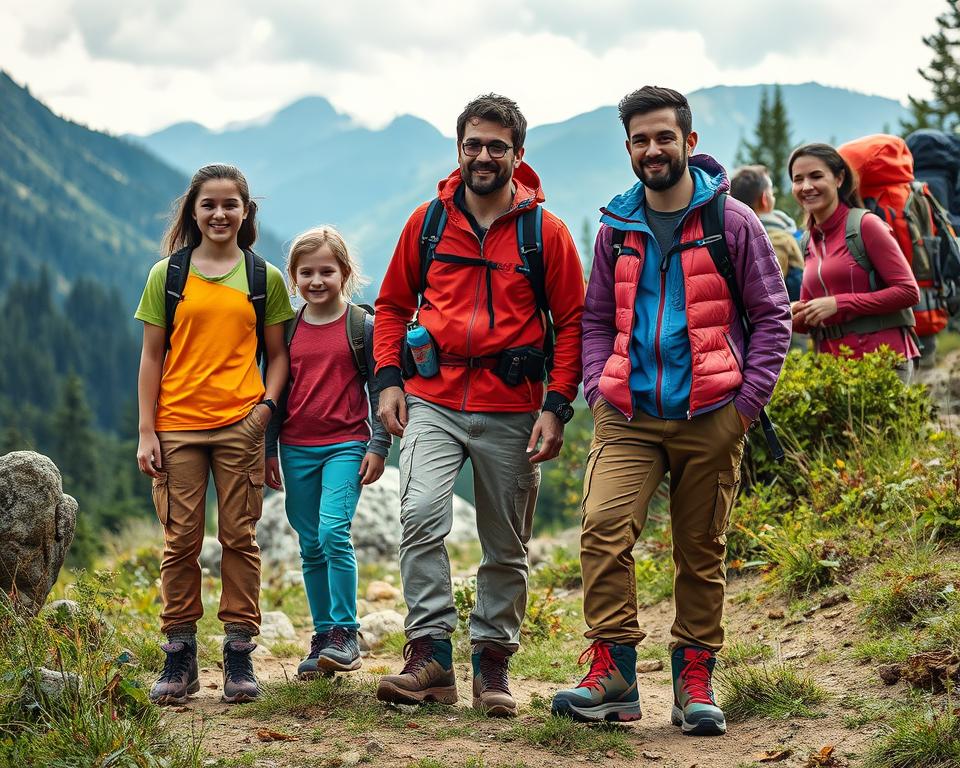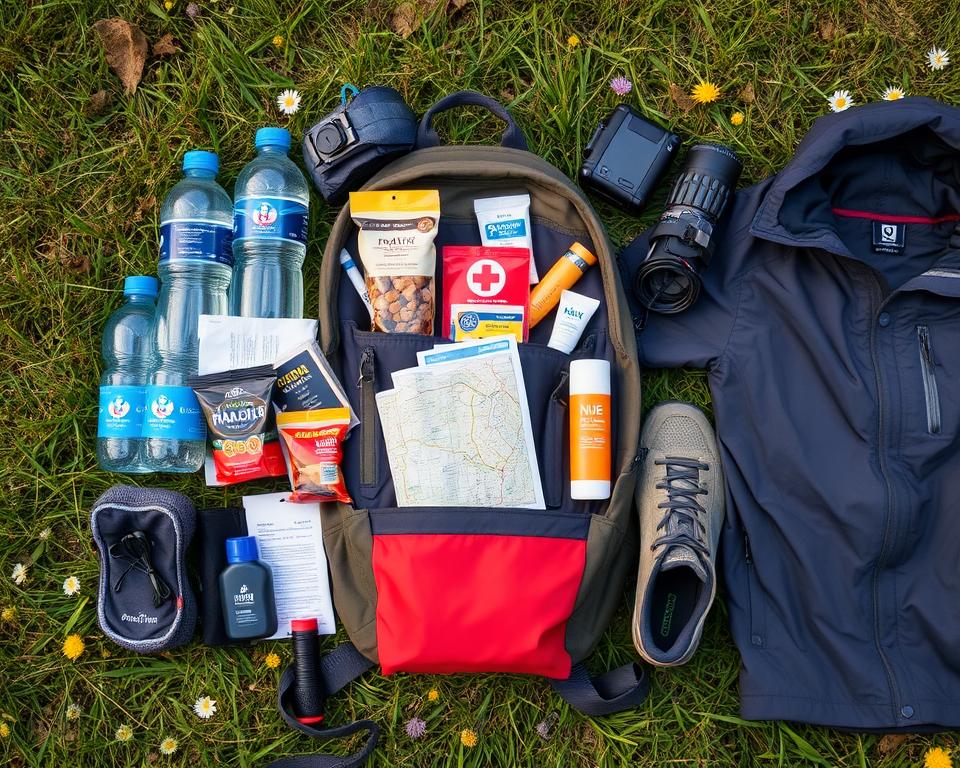A family day hike is a great way to enjoy the outdoors and bond. But, having the right gear is crucial for a good time. A thorough family hiking checklist ensures you’re ready for anything. This includes clothing for any weather, sturdy shoes, water, snacks, and safety items specific to your hike. Every piece of gear is important for comfort and safety.
Staying hydrated is key on the trail. When hiking with kids, bring at least two water bottles for each one. Your day hike packing list should have a 2-liter water bladder. For longer hikes, consider a 3-liter bladder. Pack lightweight snacks like trail mix, peanut butter pretzels, and turkey wraps.
Safety first, so include a first aid kit. It should have Band-Aids, a tick remover, ibuprofen, and other essentials. The idea of having 10 essential items for hiking has been around since the 1930s. Don’t forget your ID, a charged phone, or a solar charger. A hiking essentials for beginners list is your safety net.
Whether you’re an experienced hiker or just starting, this guide can help. It’ll help you create the perfect day hike packing list. This ensures a fun, safe, and memorable time for the whole family.
Introduction to Family Day Hiking
Going on outdoor adventures with family bonds you and lets you enjoy nature. Knowing the basics of day hiking is key to a great time. This guide is for beginners to make sure your family is ready.
First, making a hiking checklist is important. Think about the trail, weather, and season. This way, you only pack what you need. Must-haves include maps, sunscreen, warm clothes, and first-aid kits. These items can make a big difference.
For food and water, plan well. You should drink at least 1 liter of water, and half a liter every 30 minutes while hiking. Also, bring snacks that have 200-300 calories per hour. For hard hikes, aim for the top of that range.
Safety comes first. Learn trail etiquette for a good hike. Let uphill hikers pass and give solo hikers space in a group. Being nice to others, like bike or horse riders, keeps the trail friendly.
Gear is also crucial. Borrowing or renting gear, like from REI’s Re/Supply, saves money. Good hiking boots are vital. They stop blisters and support your feet, which is essential on rough paths.
Start with short hikes. Try a mile or less at first, then slowly increase. Aim for 3-4 miles, and maybe even 6 miles later on. This builds up to longer, memorable hikes for your family.
Keep these tips in mind for a safe, fun, and memorable journey into nature. Happy hiking!
What to Bring on a Family Day Hike
Getting ready for a family hike is key to fun and safety. This guide will cover what you need for a smooth adventure.
Water and Hydration Tips
Staying hydrated is key. Bring insulated bottles from Owala, or a CamelBak for cool water. Make sure everyone can drink water, especially when it’s hot. Learning about hydration can help prevent dehydration.
Snacks and Nutrition
You need to keep your energy up. Bring snacks like energy bars, trail mix, and sandwiches. Choose foods high in protein and fiber to keep your energy steady.
First Aid and Safety Items
Bring a first aid kit with bandages, antiseptics, and pain relievers. It’s important for minor injuries. Add emergency essentials like blankets, whistles, lighters, and shelters for safety.
Essential Clothing and Footwear
Choosing the right hiking clothes can really affect your comfort and how well you do on the trail. For a family day hike, it’s smart to think about what to wear for the season and layer up. This helps you stay comfy as the weather changes. Picking the right shoes for hiking makes the trip safe and fun.
Seasonal Outfit Ideas
In the warmer months, go for light hiking pants like Prana Stretch Zion for comfort and movement. Add a Patagonia Capilene Cool Daily Shirt for its sweat-wicking. For these conditions, trail runners or breathable shoes are best for keeping cool.
When it’s cold, wear a waterproof Patagonia Torrentshell 3L jacket. Under it, layer thermal underwear and a fleece jacket for warmth. Choose Gore-Tex-lined boots to keep your feet dry and warm.

Choosing the Right Hiking Shoes
Good hiking shoes stop injuries and make walking comfier. It’s key to pick shoes that support well and grip firmly. Depending on where you’re walking and the weather, you might need hiking shoes, boots, or trail runners. Gore-Tex ones are great for wet places, and non-Gore-Tex ones are cooler when it’s dry.
Layering Techniques for Comfort
Layering is a top tip for hiking. Start with a moisture-wicking base layer, like one made of merino wool or synthetic material. Then add a fleece jacket for extra warmth. Finish with a jacket that keeps out wind and rain. By layering, you can adjust to temperature changes easily during your hike.
Getting these basics right means you’ll be all set for a family day hike. You’ll be comfortable and safe, thanks to making smart choices in what you wear and the shoes you pick.
Navigation and Communication Tools
Heading out for a family day hike? Make sure to bring the right tools to stay safe and confident on the trails. A physical map and compass are classic items that are always useful. Watching videos can also teach you how to use these tools well. With compasses costing between $10 and $20, they’re a must-have for hiking.
Looking for something more modern? A GPS for trails can really change the game. These gadgets give you live tracking and updates, adding extra security when you’re in new places. Many smartphones have outdoor apps that work like a GPS. But, it’s smart to also have a map just in case your phone can’t get a signal.
Don’t forget about staying in touch. Always have a charged phone with a spare battery or a portable charger for emergencies. Turning your phone on airplane mode helps save its battery for when you really need it. You might also want to carry two-way radios or satellite messengers to talk in areas with no cell service.
Adding these navigation tools and communication devices to your hiking gear makes a big difference. Knowing how to find your way, with help from a GPS or good old map and compass, keeps you and your family safe on any trail.
What First Aid Items Should I Include in My Essential Gear for a Fun and Safe Family Day Hike?
Preparing for a family hike means packing wisely. Essential items for hikers’ first aid kits should include adhesive bandages, antiseptic wipes, gauze, and tweezers. Don’t forget to add pain relievers and a snake bite kit for extra safety. Being well-equipped ensures a fun and safe adventure for everyone!
Additional Tools and Equipment
When you plan a family day hike, choosing the right gear is crucial. It improves comfort and safety. Think about adding extra hiking gadgets and outdoor survival tools to your bag. These additions can help handle surprise challenges, making your hike smoother.
Useful Gadgets for the Trail
Gadgets can make your hike better. Take trekking poles, for example. They help on rough paths and lessen joint stress. Items like Swiss Army knives and repair kits are vital for quick fixes. And a portable water filter, such as the Sawyer Mini, is key for clean water. Such gadgets make your hike less stressful.
Emergency Preparedness
Being ready for emergencies is key. Have emergency gear like a small tent, bivouac sack, or a space blanket. These can be lifesavers during sudden weather changes. And don’t forget a good first aid kit. The Ultralight/Watertight kit from Adventure Medical Kits is a top choice.
Also pack a fire starter kit, extra batteries for headlamps, and a whistle for emergencies. With the right survival gear, you can turn potential problems into small hiccups. Being prepared means keeping your family safe, no matter what happens on the trail.

